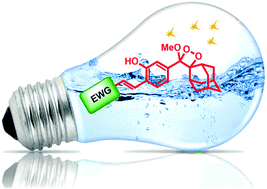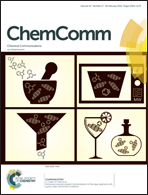The emergence of aqueous chemiluminescence: new promising class of phenoxy 1,2-dioxetane luminophores
Abstract
The majority of known chemiluminescent compounds produce light through oxidation-dependent mechanisms. The unique notion of triggering chemiluminescence by a chemical reaction other than oxidation was first introduced by Schaap in 1987 with the development of chemically and enzymatically activated phenoxy-dioxetanes. Such dioxetanes are distinctive among chemiluminescent molecules since the oxidized high-energy species, the dioxetane, is stable for years at room temperature. Light emission is selectively activated by deprotection of the phenol-protecting group. The chemiluminescence quantum yields of such dioxetanes are relatively high in organic solvents like DMSO. In aqueous solution, however, light emission efficiency drops by approximately 10 000-fold due to energy loss to water molecules. As we sought to understand the low light emission efficiency in water, we realized that the dioxetane chemiexcitation leads to the release of an excited state benzoate molecule, which is a very weak emitter under aqueous conditions. Thus, we reasoned that emission in aqueous solution could be enhanced, if the emissive nature of the excited benzoate formed in water is improved. Introduction of an electron-withdrawing acrylic group at the ortho position of the phenol donor resulted in an excited benzoate species that emits light with high efficiency in aqueous solutions. A striking 3000-fold increase in chemiluminescence emission was observed by simply using an acrylonitrile substituent on the dioxetane probe. For the first time, scientists now have an effective single-entity chemiluminescent probe that can be used to evaluate biological processes. This discovery promoted us to develop numerous highly efficient chemiluminescent probes for detection of different enzymes and analytes in aqueous solution. We anticipate that further studies in this direction will lead to even better chemiluminescence probes with quantum yield emissions that are even higher than that of the luciferin/luciferase system. In this Feature Article, we describe the insights that led us to develop these unprecedented luminophores and the historical perspective that led to the current generation of chemiluminescent phenoxy-dioxetane probes.



 Please wait while we load your content...
Please wait while we load your content...